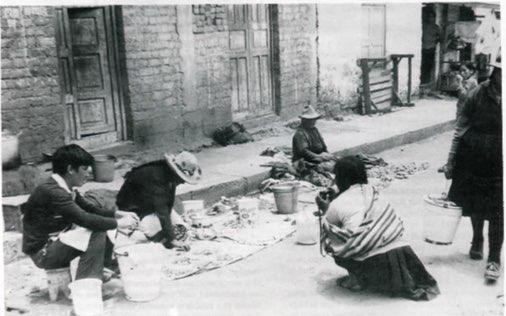Amauta Association/Peru
In 1982, the Amauta Association of Cusco, Peru promoted the organization and training of women from three poor areas of the city: Pueblo Joven Barrio de Dios, Pueblo Joven Primero de Enero and Asociacion Pro Vivienda Manawanonga. In a publication produced by themselves, the women from these communities describe their living conditions. They say:
"There are 200,000 of us living in Cusco and half of us are women. Cusco is an archeological zone with a lot of tourism but the tourists cannot imagine how we live on the sides of the hills where the majority of the people live. We do not have water, electricity or drainage. We do not have health care, markets or schools. Our only means of transportation is our feet and when it rains there is a lot of mud. We women are the first to get up in the morning and the last to go to bed at night after a hard day of work. Yet most of the time our work is not valued. Even though we participate in meetings and assemblies and always do our part of the heavy work in our neighborhood, such as carrying mud and stones, the men do not respect what we do. When one of us wants to speak up in the assemblies, for instance, they say 'It's better if your husband comes because we have to discuss these things among men.' This makes women afraid to speak up during meetings.
"These are only a few of women's problems. Most of us are illiterate. It is hard for us to meet together: we do not have time; we have no place to leave the children; our husbands don't want us to go out of the house.... But in spite of all this, we decided that we must organize ourselves to find solutions to our problems. Encouraging each other, we began to meet and talk about what is happening to us. Women need to meet. In talking together, new ideas come up and we find out what women are doing in their organizations in other places."
During their meetings, the group had the opportunity to learn about the situations of other women through pamphlets and audiovisuals. Stimulated by this, they too began to feel the need to let others know about their own opinions and to promote a dialogue about their own problems within their communities. To put this into practice, they first made a series of charts which they took around to the different neighborhoods. Then they produced a magazine and finally they decided to make an audiovisual. Through these means, they tried to give not only an analysis of their situation, but to relate the evolution of their experiences. This is what they say:
"There already was a magazine talking about women's situation in our communities. But this publication has many words and most of us do not know how to read very well. Fortunately, we received a magazine from Ecuador called Warmicuna Riman. We looked at this magazine during a literacy course and we discovered that the problems in Ecuador are very similar to ours. We liked this publication because it has a lot of photos and not many words. As soon as we saw it we said: 'We should have a magazine like this.' So, in spite of the fact that none of us had ever done this before, we began taking photographs. At first, almost all of them came out badly, but we began to learn with time. We took photographs in the market, in our neighborhoods, and in our houses to show the work women do. Afterwards, we stuck these photos on cardboard and under each one we wrote something about out problems: about work, taking care of our children, misunderstandings with our husbands. Later we took these to other neighborhoods to talk about the problems with other women. Then we made a magazine using the same material.
"Finally we decided to make an audiovisual because we thought that this was the only way we could communicate and share our experiences with many women who, like so many of us, do not know how to read. With the support of the Amauta Association, we took other photographs, wrote the texts and made the recordings. We did not conceive of this audiovisual as a final product but as a working tool to contribute to our process of development. And so, little by little, we have changed it, trying to perfect it, on the basis of suggestions and criticism which we ask for from the audience after each showing. We still do not have an evaluation of the final version. Perhaps we will keep on changing it.
"We feel that this has been an interesting and useful experience not only for ourselves but for our communities as well. We have shown our audiovisual many times in our communities and this has enabled us to discuss our situation with the whole community, men and women, young and old. But, most of all, it has given many women, including those who cannot read, the possibility to listen to what we have to say, to learn about our experiences and to become interested in changing their own situations, just as we are trying to do."



